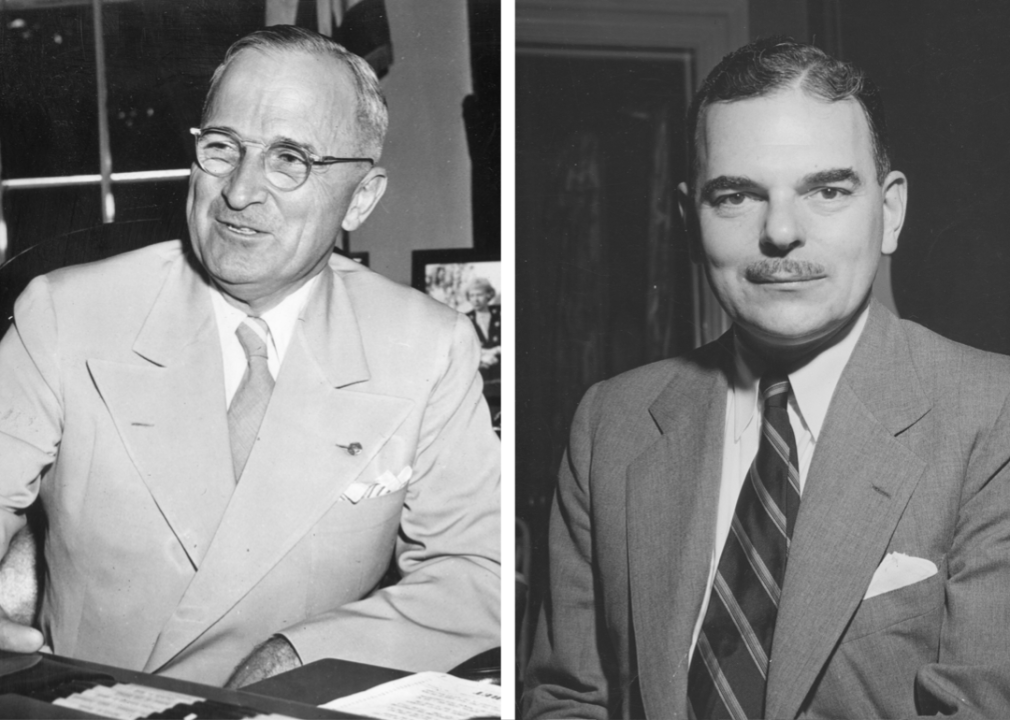5 biggest US presidential election upsets since 1872
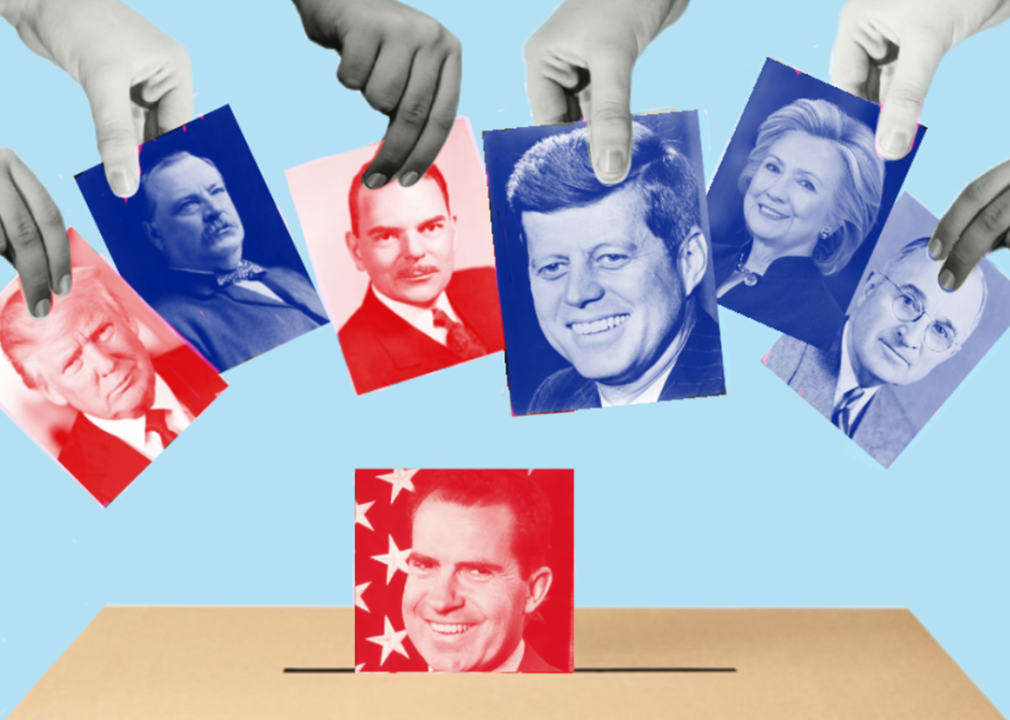
Photo Illustration by Elizabeth Ciano // Stacker // Getty Images
5 biggest US presidential election upsets since 1872
Photo illustration with portraits of Donald Trump, Grover Cleveland, Thomas E. Dewey, John F. Kennedy, Hillary Clinton, Harry Truman, and Richard Nixon.
Every U.S. presidential election cycle seems to rekindle a debate about the electoral process itself and whether it needs improving. The confusion and frustration is understandable. America isn’t a direct democracy when it comes to picking presidents. Rather, the nation uses the Electoral College process.
Here’s how it works: Instead of voting directly for president, American citizens cast ballots for their state’s electors, who then vote for the president. Each state gets assigned a number of electors based on the number of Senators and members of Congress it has, creating an Electoral College of 538 electors, 270 of which are needed to secure the presidency.
Since the nation’s founding, the electoral process has been the source of continued debate, putting election upsets in sharp relief.
An “upset” election is when the underdog, or the candidate behind in the polls, ends up defeating the favorite, the candidate projected to win. Election upsets, such as former President Donald Trump’s surprise 2016 victory against Democratic nominee Hillary Clinton, can cause an earthquake across the political landscape. His outsider win, defying the predictions of most pundits and pollsters, highlighted the limitations of polling methods at the time and showcased deep divisions in the electorate. While Trump earned 57% electoral votes, securing the election victory, Clinton won the popular vote by nearly 3 million votes.
The Electoral College system was developed, in part, to help maintain a balance of power between states and regions. Over time, however, changes in the nation’s two-party system have highlighted criticisms of potential shortcomings in the process, including that the system may give voters in swing states more power than voters in other states. These concerns have led to some calls to abolish the Electoral College, while proponents of the system argue that would swing electoral margins in favor of candidates with followings in large urban areas.
In a complicated electoral system, voters often turn to polls for clarity. But despite changes in polling practices since the 2016 election, many voters remain skeptical of their ability to reflect public opinion or accurately predict election outcomes. Polls, however, are imperfect snapshots of a moment in time, not crystal balls, and the methods of keeping them accurate and low-cost are always evolving. Polls ask samples of the population a series of questions and then use statistical models to extrapolate and estimate the overall sentiment.
Many factors contribute to a poll’s accuracy, and assessing the credibility of polls can be challenging for the average American. Techniques such as polling a representative sample of the electorate through random sampling and including a poll’s margin of error help bolster credibility. Meanwhile, the phrasing of polling questions and the influence of funders or groups behind the poll on its methodology can lead to skewed results.
As the country changes, cost-effective polling methods must also keep pace. Phone-based surveys were considered the gold standard in polling for many years, but with fewer people answering their phones, pollsters now use a range of techniques, including web surveys and panels. These methods are cheaper and scalable, but they can exclude those without reliable phone or internet access and lack the focus of a live interview.
With current favorability polls showing a small margin between the presidential candidates, Americans will likely be watching the polls closely. In the coming weeks, with the possibility of another underdog victory on the horizon, voters may also benefit from looking to the past to better understand how previous elections have dramatically reshaped the nation’s politics.
ATS.io compiled a list of the top five biggest U.S. presidential election upsets since 1872 using data from Sports Odds History. Presidential upsets were ranked according to the preelection odds of the runner-up, taken as close to Election Day as possible.
![]()
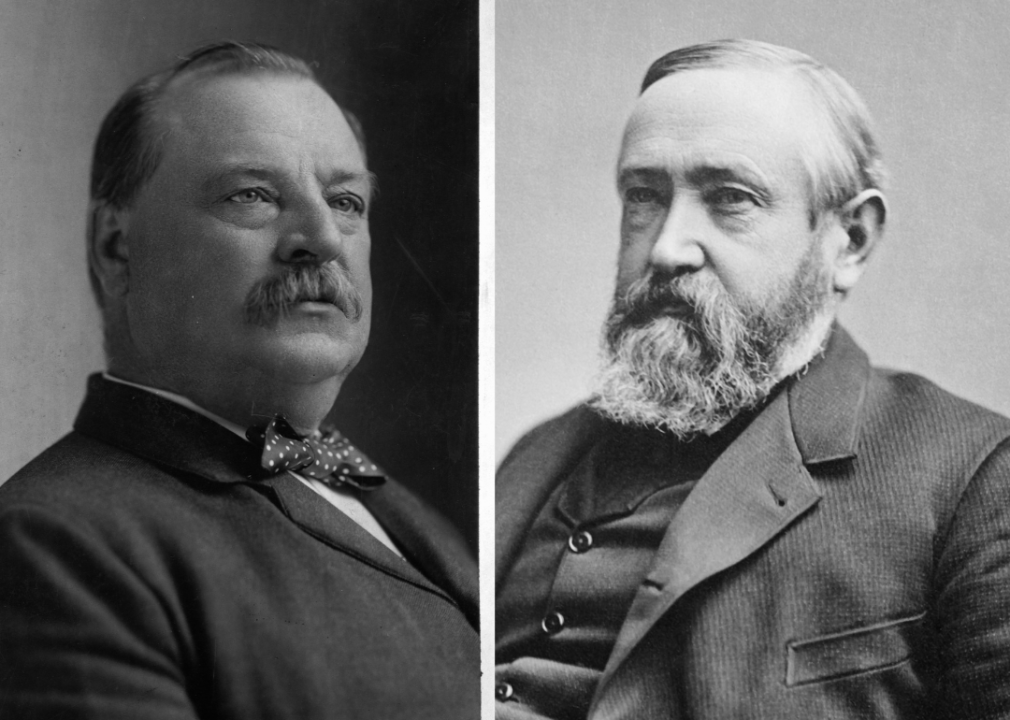
Library of Congress/Corbis/VCG via Getty Images ; Everett Collection // Shutterstock
#5. Grover Cleveland defeats Benjamin Harrison (1892)
Portraits of Grover Cleveland and Benjamin Harrison.
– Preelection odds: -125
– Electoral College results: 277-145
– Popular vote results: 46%-43%
In 1892, Grover Cleveland, the former president who served from March 1885 to March 1889, staged a remarkable comeback to defeat incumbent Benjamin Harrison. The campaign was marked by fiery debates over tariffs and economic policies, particularly the concept of sound currency. Cleveland hammered Harrison’s protectionist stance, which many blamed for rising costs of living.
The key battleground states, including New York and Indiana, swung decisively in Cleveland’s favor, driven by widespread discontent with the Republican administration’s handling of the economy. Despite losing the Electoral College in 1888 (while winning the popular vote), Cleveland’s win this time around was a clear rejection of Harrison’s presidency. As Cleveland became the only president to serve nonconsecutive terms, the victory signaled a shift toward economic reform and foreshadowed the challenges that would define his second term, including labor unrest and financial instability.
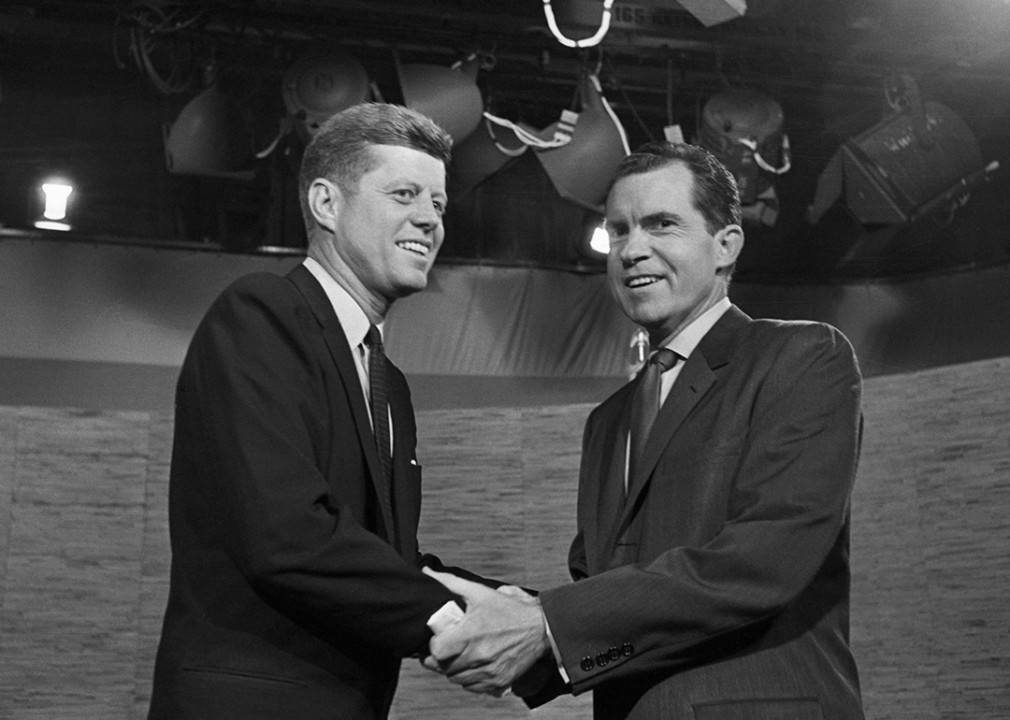
Bettmann // Getty Images
#4. John F. Kennedy defeats Richard Nixon (1960)
John F. Kennedy and Richard Nixon shake hands after their televised debate.
– Preelection odds: -130
– Electoral College results: 303-219
– Popular vote results: 49.7%-49.6%
John F. Kennedy’s narrow victory over Richard Nixon in the 1960 presidential election stunned the nation and marked a turning point in American politics. The campaign was fiercely fought, with the first-ever televised debates playing a pivotal role—Kennedy’s confident, charismatic performance contrasted sharply with Nixon’s tired appearance, swaying many undecided voters.
Key battleground states like Illinois and Texas tipped the scales in Kennedy’s favor, with his appeal to younger voters and communities of color proving decisive. As Kennedy took office, his “new frontier” message resonated with a public eager for change, setting the stage for a presidency focused on optimism and progress.
Kennedy grappled with Cold War tensions, including the Cuban Missile Crisis. Under his administration, anti-poverty initiatives were passed, but many other efforts were blocked by conservative Republicans and Southern Democrats. Kennedy’s presidency was cut short by his assassination in 1963, but his legacy highlighted the power of the media in shaping public perception.
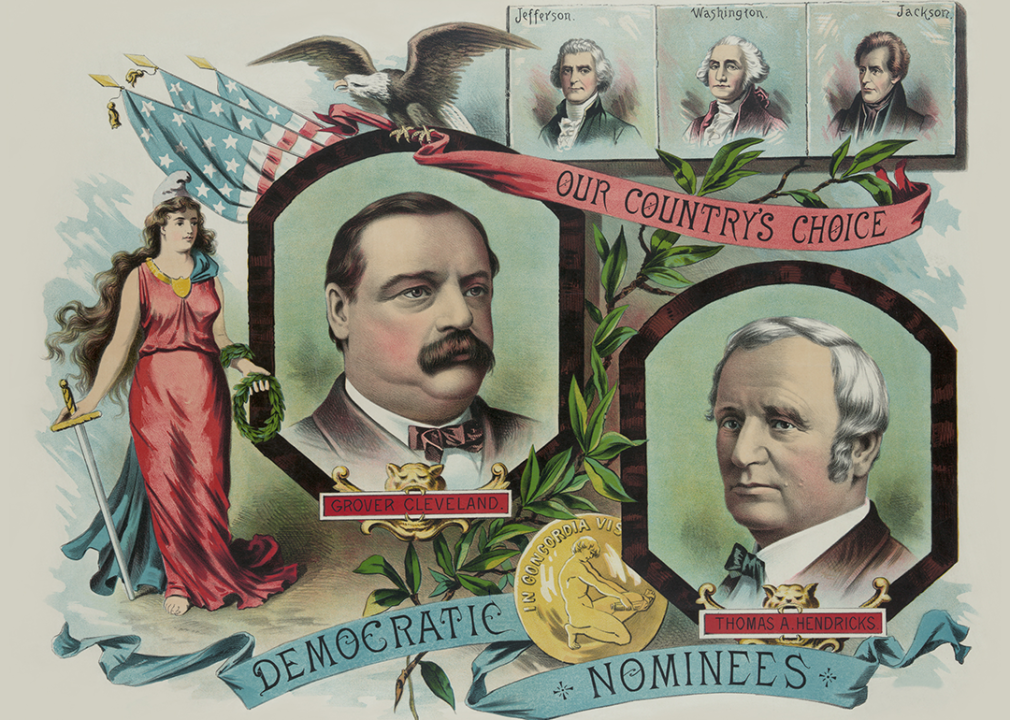
Buyenlarge // Getty Images
#3. Grover Cleveland defeats James Blaine (1884)
Campaign illustration showing Democratic Party nominees in 1884 Grover Cleveland and Thomas Hendricks.
– Preelection odds: -150
– Electoral College results: 219-182
– Popular vote results: 48.9%-48.3%
Grover Cleveland’s unexpected victory over James Blaine in the 1884 presidential election came after a fierce mudslinging campaign. Blaine struggled to shake off corruption allegations, while Cleveland’s campaign was bogged down by the revelation that he had fathered a child out of wedlock.
Despite the scandals, Cleveland’s image as a reform-minded leader resonated with voters fed up with political corruption. He carried the South and won several key states like New York and Missouri. Blaine secured the West and many northern states, but lost New York just one-tenth of a percentage point, losing the 36 electoral votes that would have secured the presidency. Cleveland’s victory marked a significant shift as Democrats reclaimed the presidency for the first time since the Civil War, reflecting a public craving for reform and transparency.
Once in office, Cleveland set about reducing political patronage by filling government positions based on merit rather than connections and pushed for reforms in interstate commerce and the Navy. His administration’s focus on integrity signaled a broader movement toward cleaner politics and greater accountability.
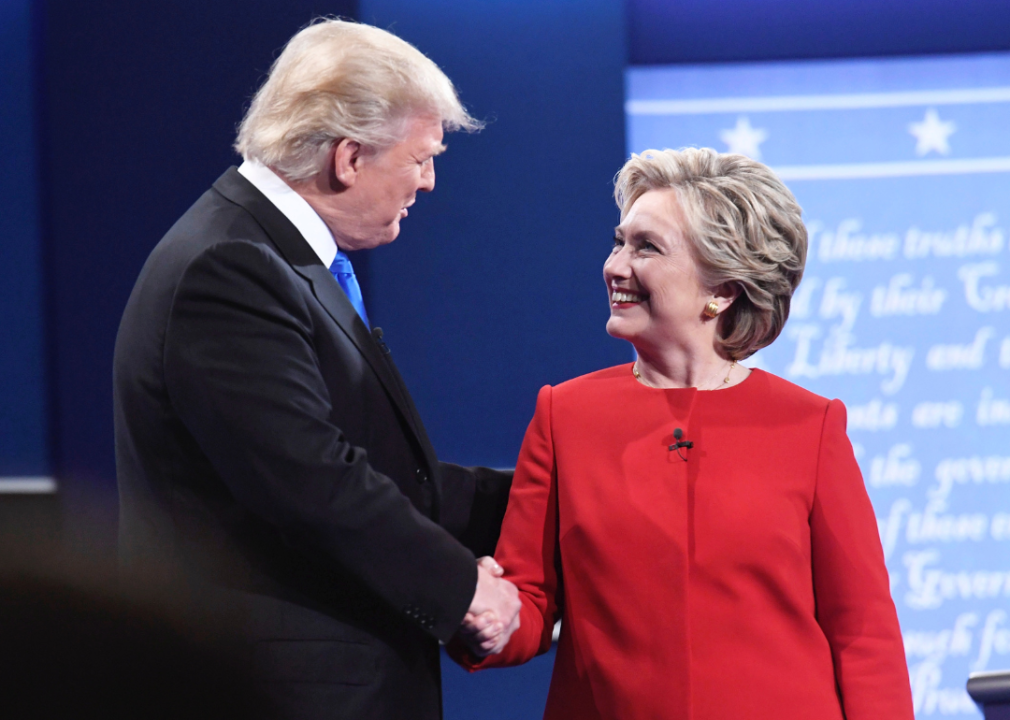
Alejandra Villa Loarca/Newsday RM via Getty Images
#2. Donald Trump defeats Hillary Clinton (2016)
Donald Trump and Hillary Clinton shake hands at a 2016 debate.
– Preelection odds: -550
– Electoral College results: 304-227
– Popular vote results: 46.1%-48.2%
Donald Trump’s shocking 2016 presidential election victory over Democratic nominee Hillary Clinton upended the country’s political orthodoxy. The campaign itself was fraught with controversy and surprises, from taped revelations of Trump’s sexual misconduct to allegations of Russian interference, the FBI’s late-stage announcement that it was investigating Clinton’s handling of government emails, and Trump’s expectation-beating debate performance.
Trump won crucial battleground states like Pennsylvania, Michigan, and Wisconsin, narrowly flipping traditional Democratic strongholds by appealing to disaffected voters in rural and industrial areas who felt left behind by the downsides of economic globalization. As Trump assumed office, his election signaled a hard-right populist turn that would challenge conventional politics, intensify partisan divides, and foreshadow future turbulence.
FPG/Archive Photos // Getty Images
#1. Harry Truman defeats Thomas Dewey (1948)
Portraits of Harry S. Truman and Thomas E. Dewey.
– Preelection odds: -1,800
– Electoral College results: 303-189
– Popular vote results: 49.6%-45.1%
Severely down in the polls and facing a nation in the grips of postwar inflation and beset by labor strikes, Democratic nominee Harry S. Truman embarked on a relentless whistle-stop tour, crisscrossing the country by rail and connecting directly with voters, particularly in key states like Ohio and Illinois. His fierce speeches, hitting Republicans hard over their support for the anti-labor Taft-Hartley Act, revved up crowds and stood in stark contrast to Thomas Dewey’s intentionally tempered and inoffensive oratory.
The campaign paid off, and Truman’s surprise victory wasn’t just a rejection of Republican overconfidence. It was also an endorsement of the New Deal policies of Franklin D. Roosevelt, whom Truman served with as vice president, signaling the public’s desire for continuity and reform. As he stepped into office, Truman’s victory highlighted a growing divide between political elites and the average voter, a rift that would shape the next phase of American politics.
Data reporting by Karim Noorani. Story editing by Alizah Salario. Additional editing by Kelly Glass. Copy editing by Tim Bruns.
This story originally appeared on ATS.io and was produced and distributed in partnership with Stacker Studio.
